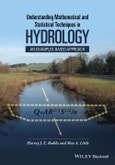Understanding Mathematical and Statistical Techniques in Hydrology provides full and detailed expositions of such equations and mathematical concepts, commonly used in hydrology. In contrast to other hydrological texts, instead of presenting abstract mathematical hydrology, the essential mathematics is explained with the help of real-world hydrological examples.
Table of Contents
Preface vii
How to use this book x
1 Fundamentals 1
1.1 Motivation for this book 1
1.2 Mathematical preliminaries 2
2 Statistical modelling 19
2.1 The Central European Floods, August 2002 19
2.2 Extreme value analysis 22
2.3 Simple methods of return period estimation 22
2.4 Return periods based on distribution fitting 25
2.5 Techniques for parameter estimation 30
2.6 Bayesian parameter estimation 30
2.7 Resampling methods: bootstrapping 31
3 Mathematics of hydrological processes 34
3.1 Introduction 34
3.2 Algebraic and difference equation methods 34
3.3 Methods involving exponentiation 36
3.4 Rearranging model equations 36
3.5 Equations with iterated summations and products 38
3.6 Methods involving differential equations 41
3.7 Methods involving integrals 43
4 Techniques based on data fitting 45
4.1 Experimental and observed data 45
4.2 Rating curves 46
4.3 Regression with two or more independent variables 49
4.4 Demonstration of decaying quantities 51
4.5 Analysis based on harmonic functions 52
5 Time series data 55
5.1 Introduction 55
5.2 Characteristics of time series data 55
5.3 Testing for time dependence 57
5.4 Testing for trends 58
5.5 Frequency analysis 59
5.6 Other analysis methods 60
5.7 Smoothing and filtering 60
5.8 Linear smoothing and filtering methods 61
5.9 Nonlinear filtering methods 64
5.10 Time series modelling 66
5.11 Hybrid time series/process-based models 67
5.12 Detecting non-stationarity 69
6 Measures of model performance, uncertainty and stochastic modelling 71
6.1 Introduction 71
6.2 Quantitative measures of performance 71
6.3 Comparing measures 73
6.4 The Nash–Sutcliffe method 75
6.5 Stochastic modelling 76
6.6 Monte Carlo simulations 77
6.7 Non-uniform Monte Carlo sampling 79
6.8 Uncertainty in hydrological modelling 81
6.9 Uncertainty in combined models 82
6.10 Assessing uncertainty given observed data: Bayesian methods 83
Glossary 86
Index 88








